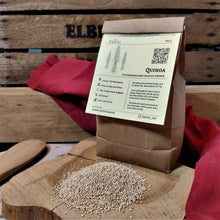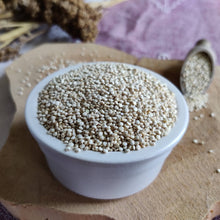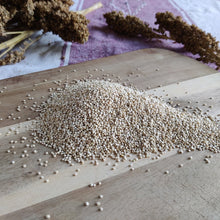400gr
With its sweet and nutty flavour, quinoa is one of the tastiest replacers of rice in a dish. Quinoa has a high protein content and it is rich in folic acid, manganese, vitamin B and many other important trace elements (see nutrition tab below). Find the nutritional value and how to cook the quinoa down below in the tabs.
Arjen and Winny grew this quinoa at a field surrounded by forests and mixed flower strips that they have sown all around the field.
Complete product details
Details
At a glance:
- Wholemeal
- Saponin free
- High protein
- Grown in The Netherlands
- Long shelf-life
Detailed information:
- Produced in: Lochem, The Netherlands
- Produced by: Arjen van Buuren and Winny van Buuren-Tessers
- Field objective: Grain rich field ( 4 of 6 years grain crop)
- Certificates of grower: Organic certified
- Processed by: Van De Bilt Zaden en Vlas
- Transport mode to warehouse: Transporter van
- Bulk storage: Multi-layered paper bags of 25 kg
- Packaging: unbleached kraft paper bag
- How to recycle: Refill packaging with paper and carton
Cooking
This quinoa does not need rinsing as it is free of saponin.- Use the ratio of 2 cups water for every 1 cup of quinoa. Bring to boil, add the quinoa and close off with a lid. Let it simmer on low heat for about 15 minutes.
- The grains will swell and increase by two or threefold, Fluff the grains with a spoon before serving.
Nutrition
Quinoa is considered super healthy, as the seeds are loaded with protein and fibres. Not less important is the availability of vitamin E, B1, B6, folium acid, phosphorus, magnesium and iron. Check out the nutritional value table to find the details.
Quinoa also contains all 9 essential amino acids (building blocks of protein).
This product may contain traces of gluten.
| Nutritional value | per 100 gram | Per portion (50 g) | RI* |
| Energy | 1538 kJ (367 kcal) | 769 kJ (184 kcal) | |
| Fat | 6 g | 3 g | |
| Of which saturated | 0.8 g | 0.4 g | |
| Carbohydrates | 60 g | 30 g | |
| Of which sugar | 3 g | 1.5 g | |
| Fibre | 7 g | 3.5 g | |
| Protein | 14 g | 7 g | |
| Salt | 0.01 g | 0 g | |
| Potassium | 732 mg | 366 mg | 37% |
| Phosphorus | 435 mg | 218 mg | 62% |
| Magnesium | 198 mg | 99 mg | 53% |
| Iron | 6.2 mg | 3.1 mg | 44% |
| Zinc | 2.7 mg | 1.4 mg | 27% |
| Copper | 0.4 mg | 0.2 mg | 40% |
| Manganese | 2.4 mg | 1.2 mg | 120% |
| Vitamin E | 3.8 mg | 1.9 mg | 32% |
| Thiamin/vitamin B1 | 0.62 mg | 0.31 mg | 56% |
| Vitamin B6 | 0.53 mg | 0.27 mg | 38% |
| Folic acid/ vitamin B9-B11 | 197 µg | 99 µg | 99% |
*Reference intake of an average adult ( 8400 kJ/2000 kcal) per 100gr
Sustainability
When we think of quinoa, we often think of its origin from South-America. Which is totally fair! Though, quinoa is actually a very close relative to a common European weed, called Goosefeet. And therefore also quinoa can perfectly grow in north-western Europe! So, now we do not have to ship it halfway across the world and we are not contributing any longer to the desertification that often comes along with quinoa production in South-America.
The Dutch agricultural landscape majorly consists of 5 crops. Grains and also pseudo-grains, like quinoa, are not in that top 5. Whilst most of our calories come from exactly these kernel producing crops. Having a broader diversity of crops in a landscape increases resistance, wildlife habitat and the health of our soils.
All with all, technical phrases to say: Let's produce a wide spectrum of food locally when we can. Your food choices make this possible!
Producer
In the east of the Netherlands, in the middle of a beautiful country estate named Velhorst, small diverse fields make up the landscape in which Arjen and Winny produce a wide variety of crops and manage a herd of different farm animals.
The quinoa was grown on a 1.4-hectare field, surrounded by deciduous forests with a 3-meter wildflower barrier in between.







